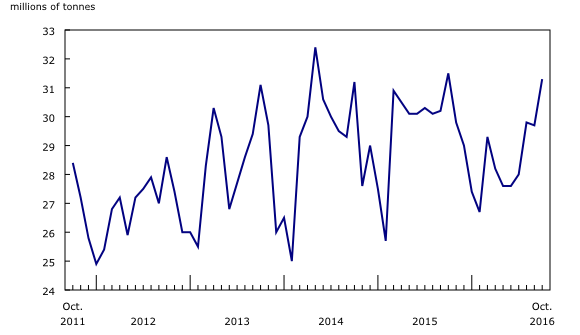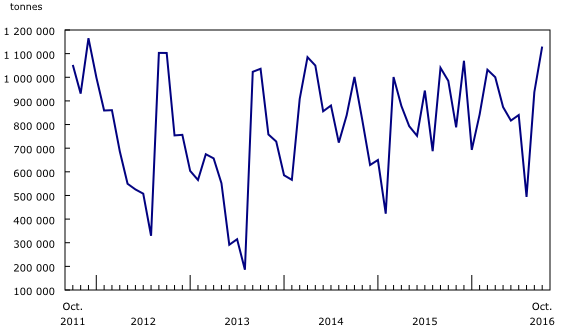Railway carloadings, October 2016
Archived Content
Information identified as archived is provided for reference, research or recordkeeping purposes. It is not subject to the Government of Canada Web Standards and has not been altered or updated since it was archived. Please "contact us" to request a format other than those available.
Released: 2016-12-21
31.3 million tonnes
October 2016
-0.6% 
(12-month change)
The volume of rail freight carried in Canada totalled 31.3 million tonnes in October, down 0.6% from the same month last year.
In October, freight originating in Canada decreased 0.3% from the same month last year to 28.5 million tonnes.
Non-intermodal freight decreased 0.8% to 307,260 carloads in October. The amount of freight loaded onto these cars declined 0.1% from the same month a year earlier to 25.7 million tonnes.
Tonnages of iron ores and concentrates (-5.8%), fuel oils and crude petroleum (-20.4%), other chemical products and preparations (-53.1%) and nickel ores and concentrates (-72.6%) shipped by rail declined in October on a year-over-year basis.
In comparison, tonnages of other oil seeds and nuts and other agricultural products (+40.0%), colza seeds (canola) (+14.7%), gasoline and aviation turbine fuel (+55.2%) and logs and other wood in the rough (+148.2%) were up in October compared with the same month last year.
Intermodal freight loadings decreased 1.7% to 190,737 units from October 2015 to October 2016. The 1.4% decrease in containers-on-flat-cars moderated the 15.9% decline in trailers-on-flat-cars. In terms of weight, intermodal traffic decreased 1.9% to 2.8 million tonnes.
Freight traffic received from the United States fell 3.8% to 2.8 million tonnes as a result of a 3.7% decrease in non-intermodal freight and a 4.9% decrease in intermodal freight from the United States.
Canola: Farm to market
Canadian farmers grew 18.4 million tonnes of canola in 2015. Rail is an important part of the supply chain to get this product to both foreign and domestic markets and canola represented 4.4% of total non-intermodal rail traffic in October 2016. For January to October 2016, colza seed (canola) rail shipments are ahead of the same period in 2015 by more than 500 000 tonnes.
China is the Canada's biggest market for canola seed, buying 4.0 million tonnes of the 9.5 million tonnes exported in 2015. These exports are shipped by rail from elevators, mainly from the Prairie provinces, to ports on the Pacific coast.
In 2013, the bumper crop of agricultural products led to a bottleneck in the grain supply chain. Record amounts of agricultural products competed with each other and with other resources, such as coal, iron ore and fuel oils, for transportation. As a result, the monthly rail data show that the harvest shipments of canola (September, October and November) in 2013 were actually down a combined 142 723 tonnes from 2012. However, the spring 2014 shipments (March, April and May) were up by a combined 1.2 million tonnes from 2013, as product that was not moved by rail the previous year was taken out of storage and shipped.
Note to readers
The Monthly Railway Carloadings Survey collects data, including the number of rail cars, tonnage, units and 20-feet equivalent units, from railways operating in Canada that provide for-hire freight service.
Non-intermodal freight is cargo moved via box cars or loaded in bulk. Intermodal freight is cargo moved via containers and trailers on flat cars.
Data are available for Canada, the eastern division and the western division. For statistical purposes, cargo loadings from Thunder Bay, Ontario, to the Pacific Coast are classified to the western division, while loadings from Armstrong, Ontario, to the Atlantic Coast are classified to the eastern division.
Data in this release are not seasonally adjusted.
Data on production of canola crops are available in CANSIM table 001-0010 while data on exports of grain by final destination are available in table 001-0015.
Contact information
For more information, or to enquire about the concepts, methods or data quality of this release, contact us (toll-free 1-800-263-1136; 514-283-8300; STATCAN.infostats-infostats.STATCAN@canada.ca) or Media Relations (613-951-4636; STATCAN.mediahotline-ligneinfomedias.STATCAN@canada.ca).
- Date modified:



